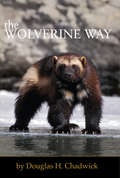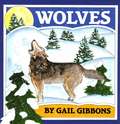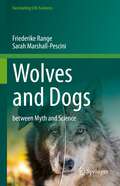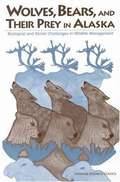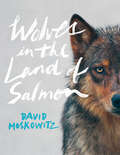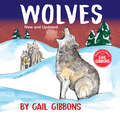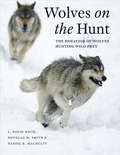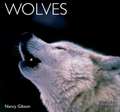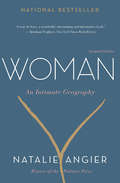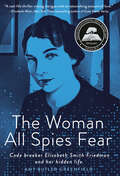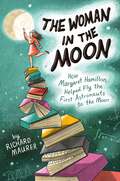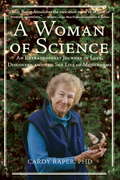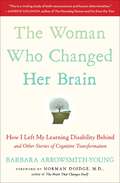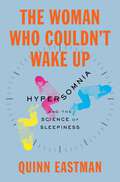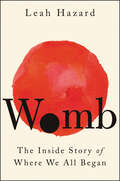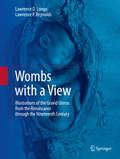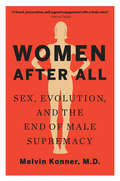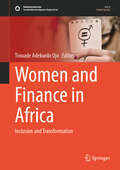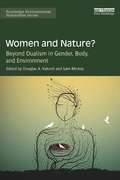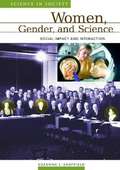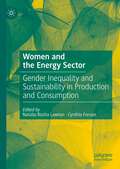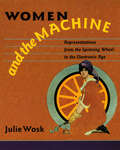- Table View
- List View
The Wolverine Way
by Douglas H. ChadwickGlutton, demon of destruction, symbol of slaughter, mightiest of wilderness villains... The wolverine comes marked with a reputation based on myth and fancy. Yet this enigmatic animal is more complex than the legends that surround it. With a shrinking wilderness and global warming, the future of the wolverine is uncertain. The Wolverine Way reveals the natural history of this species and the forces that threaten its future, engagingly told by Douglas Chadwick, who volunteered with the Glacier Wolverine Project. This five-year study in Glacier National Park - which involved dealing with blizzards, grizzlies, sheer mountain walls, and other daily challenges to survival - uncovered key missing information about the wolverine's habitat, social structure and reproduction habits. Wolverines, according to Chadwick, are the land equivalent of polar bears in regard to the impacts of global warming. The plight of wolverines adds to the call for wildlife corridors that connect existing habitat that is proposed by the Freedom to Roam coalition.
Wolves
by Gail GibbonsThey look like big dogs, but wolves live very differently than our pets. Read about the way wolves live on their own in the wild. Tales about wolves are included.
Wolves and Dogs: between Myth and Science (Fascinating Life Sciences)
by Friederike Range Sarah Marshall-PesciniVarious parallels have been drawn between wolves and humans from the perspective of their social organisation. Therefore, studying wolves may well shed light on the evolutionary origins of complex human cognition and, in particular, on the role that cooperation played in its development. Humans closely share their lives with millions of dogs – the domesticated form of wolves. Biologically, wolves and dogs can be considered to be the same species; yet only dogs are suitable living companions in human homes, highlighting the importance of cognitive and emotional differences between the two forms. The behaviour of wolves and dogs largely depends on the environment the animals grew up and live in. This book reviews more than 50 years of research on the differences and similarities of wolves and dogs. Beyond the socio-ecology, the work explores different theories about when and how the domestication of wolves might have started and which behaviours and cognitive abilities might have changed during this process. Readers will discover how these fascinating animals live with their conspecifics in their social groups, how they approach and solve problems in their daily lives and how they see and interact with their human partners.
Wolves, Bears, and Their Prey in Alaska: Biological and Social Challenges in Wildlife Management
by National Research CouncilThis book assesses Alaskan wolf and bear management programs from scientific and economic perspectives. Relevant factors that should be taken into account when evaluating the utility of such programs are identified. The assessment includes a review of current scientific knowledge about the dynamics and management of large mammalian predator-prey relationships and human harvest of wildlife in northern ecosystems, and an evaluation of the extent to which existing research and management data allow prediction of the outcome of wolf management or control programs and grizzly bear management programs. Included is an evaluation of available economic studies and methodologies for estimating the costs and benefits of predator control programs in Alaska.
Wolves in the Land of Salmon
by David MoskowitzLong considered an icon of the wild, wolves capture our imagination and spark controversy. Humans are the adult wolf’s only true natural predator; its return to the old-growth forests and wild coastlines of the Pacific Northwest renews age-old questions about the value of wildlands and wildlife. As the vivid stories unfold in this riveting and timely book, wolves emerge as smart, complex players uniquely adapted to the vast interdependent ecosystem of this stunning region. Observing them at close range, David Moskowitz explores how they live, hunt, and communicate, tracing their biology and ecology through firsthand encounters in the wildlands of the Northwest. In the process he challenges assumptions about their role and the impact of even well-meaning human interventions.
Wolves (New & Updated Edition)
by Gail GibbonsFrom the beloved science writer Gail Gibbons, rethink what you know about big bad wolves in this kid-friendly, illustrated guide with the latest facts from experts.While most people think of hungry fangs when they think of wolves, modern research has proven wolves are not the dangerous threat many thought them to be. This new edition, vetted by an expert, presents the latest scientific information on wolves in language accessible for young readers through vibrant, detailed illustrations and easy-to-read text. Kids will love seeing wolves roam the snowy, watercolor landscape while learning new, surprising facts about this often-misunderstood animal. Wolves tend to be shy and live peacefully among themselves in territories as large as 500 square miles. Pack leaders mate for life, and pack member hunt together, share food, and protect each other. See how wolves communicate with clearly labelled and expressive artwork. Read updated information on wolf hunting territories and the wolf pup development. Bonus pages include myths and legends about wolves, and a list of curious facts. Author of over 120 nonfiction books for kids, including the Gorillas and Migration, and with hundreds of thousands of books sold, Gail Gibbons continues to bring science to kids in this deep dive into the lives of wolves.
Wolves on the Hunt: The Behavior of Wolves Hunting Wild Prey
by Daniel R. Macnulty Douglas W. Smith L. David MechThe interactions between apex predators and their prey are some of the most awesome and meaningful in nature--displays of strength, endurance, and a deep coevolutionary history. And there is perhaps no apex predator more impressive and important in its hunting--or more infamous, more misjudged--than the wolf. Because of wolves' habitat, speed, and general success at evading humans, researchers have faced great obstacles in studying their natural hunting behaviors. The first book to focus explicitly on wolf hunting of wild prey, Wolves on the Hunt seeks to fill these gaps in our knowledge and understanding. Combining behavioral data, thousands of hours of original field observations, research in the literature, a wealth of illustrations, and--in the e-book edition and online--video segments from cinematographer Robert K. Landis, the authors create a compelling and complex picture of these hunters. The wolf is indeed an adept killer, able to take down prey much larger than itself. While adapted to hunt primarily hoofed animals, a wolf--or especially a pack of wolves--can kill individuals of just about any species. But even as wolves help drive the underlying rhythms of the ecosystems they inhabit, their evolutionary prowess comes at a cost: wolves spend one-third of their time hunting--the most time consuming of all wolf activities--and success at the hunt only comes through traveling long distances, persisting in the face of regular failure, detecting and taking advantage of deficiencies in the physical condition of individual prey, and through ceaseless trial and error, all while risking injury or death. By describing and analyzing the behaviors wolves use to hunt and kill various wild prey--including deer, moose, caribou, elk, Dall sheep, mountain goats, bison, musk oxen, arctic hares, beavers, and others--Wolves on the Hunt provides a revelatory portrait of one of nature's greatest hunters.
Wolves (World Life Library)
by Nancy GibsonThis top-selling series introduces the wild creatures of the world and examines the natural world. Good general introductions for ages 10+, these volumes contain the knowledge, personal experiences, and research of leading naturalists and scientists, accompanied by stunning photography.
Woman: An Intimate Geography
by Natalie AngierNational Book Award Finalist: This look at the science of the female body is &“a tour de force . . . wonderful, entertaining and informative&” (TheNew York Times Book Review). From a Pulitzer Prize–winning journalist who covers science for the New York Times, Woman is an essential guide to everything from organs to orgasms and hormones to hysterectomies. With her characteristic clarity and insight, Natalie Angier cuts through still-prevalent myths and misinformation surrounding the female body, the most enigmatic of evolutionary masterpieces. In addition to earning a nomination for the National Book Award, Woman was named one of the best books of the year by NPR, the Los Angeles Times, the Chicago Tribune, and People, among others. &“One knows early on one is reading a classic—a text so necessary and abundant and true that all efforts of its kind, for decades before and after it, will be measured by it.&” —Los Angeles Times &“Ultimately, this grand tour of the female body provides a new vision of the role of women in the history of our species.&” —The Washington Post
The Woman All Spies Fear: Code Breaker Elizebeth Smith Friedman and Her Hidden Life
by Amy Butler GreenfieldAn inspiring true story, perfect for fans of Hidden Figures, about an American woman who pioneered codebreaking in WWI and WWII but was only recently recognized for her extraordinary contributions.Elizebeth Smith Friedman had a rare talent for spotting patterns and solving puzzles. These skills led her to become one of the top cryptanalysts in America during both World War I and World War II. She originally came to code breaking through her love for Shakespeare when she was hired by an eccentric millionaire to prove that Shakespeare's plays had secret messages in them. Within a year, she had learned so much about code breaking that she was a star in the making. She went on to play a major role decoding messages during WWI and WWII and also for the Coast Guard's war against smugglers. Elizebeth and her husband, William, became the top code-breaking team in the US, and she did it all at a time when most women weren't welcome in the workforce. Amy Butler Greenfield is an award-winning historian and novelist who aims to shed light on this female pioneer of the STEM community.
Woman in the Mists: The Story of Dian Fossey and the Mountain Gorillas of Africa
by Farley MowatDeep in Central Africa live some of the most intriguing animals on earth: the mountain gorillas. The extraordinary woman who pursued her dream to study them was Dian Fossey.
The Woman in the Moon: How Margaret Hamilton Helped Fly the First Astronauts to the Moon
by Richard MaurerA stunning and intimate biography of Margaret Hamilton, the computer engineer who helped Apollo 11 and mankind get from the Earth to the moon.First-hand accounts, exclusive interviews with the legendary Margaret Hamilton, and detailed science populate the pages of this remarkable biography. In 1969, mankind successfully left our atmosphere and landed on the moon. It took countless hours of calculations, training, wonder, and sacrifice from all of the men and women who worked hard to make that landing. One of those people was Margaret Hamilton. A young computer engineer, Hamilton was hired to develop the completely new software used in the groundbreaking Apollo Space Program. Soon she became the lead engineer, one of the few women in the almost entirely male-dominated profession. But it wasn't always easy. In The Woman in the Moon, science-writer and journalist Richard Maurer (Destination Moon, 2019) dives deep into the backstory of this extraordinary woman. With first-hand interviews and access to primary sources, this striking biography perfectly captures the exciting atmosphere of the Space Race and the inspiring figure of Margaret Hamilton.
A Woman of Science
by Cardy Raper Remeline DamascoA STORY OF TRUE LOVE, DETERMINATION, SACRIFICE, AND DISCOVERY.A Woman of Science catalogues a decades-long journey of inspirational hardship and success that serves as a model for what women can do in a field largely dominated by men.Cardy Raper succeeded in becoming what she dreamed of as a young girl: a scientist. This beautifully written memoir details her struggles with the "boys' club" mentality of the scientific and academic worlds, her grief over her husband's premature passing, and above all her relentless, passionate efforts to unlock the secrets of mushroom gender and reproduction.Cardy Raper is not a woman to accept "no" for an answer. When her mother told her that she could be a nurse when she grew up, Cardy informed her in no uncertain terms that she was going to be a true scientist, making grand discoveries. Science was a man's world then. But despite lack of encouragement through college, Cardy learned what she needed. Then, at the University of Chicago, she met her mentor, John "Red" Raper, an equally stubborn and spirited scientist. They became soul mates, and, together, studied sexual reproduction in the amazing water mold Achlya. Cardy and Red married, had children, and continued to share their passion for science by unraveling the means of sexual reproduction in mushroom-bearing fungi. They moved to Harvard University and continued their research. Years later, Red's untimely death left Cardy alone in the competitive world of cutting-edge science. But Cardy carried on. She achieved her doctoral degree, learned the techniques of molecular genetics, and established her own laboratory. Ultimately, Cardy's discoveries helped to uncover the way in which genes found throughout the animal kingdom--including humans--encode molecules for mating, sight, smell, and taste.
The Woman That Never Evolved: With a New Preface and Bibliographical Updates, Revised Edition
by Sarah Blaffer HrdyWhat does it mean to be female? Sarah Blaffer Hrdy--a sociobiologist and a feminist--believes that evolutionary biology can provide some surprising answers. Surprising to those feminists who mistakenly think that biology can only work against women. And surprising to those biologists who incorrectly believe that natural selection operates only on males. In The Woman That Never Evolved we are introduced to our nearest female relatives competitive, independent, sexually assertive primates who have every bit as much at stake in the evolutionary game as their male counterparts do. These females compete among themselves for rank and resources, but will bond together for mutual defense. They risk their lives to protect their young, yet consort with the very male who murdered their offspring when successful reproduction depends upon it. They tolerate other breeding females if food is plentiful, but chase them away when monogamy is the optimal strategy. When "promiscuity" is an advantage, female primates--like their human cousins--exhibit a sexual appetite that ensures a range of breeding partners. From case after case we are led to the conclusion that the sexually passive, noncompetitive, all-nurturing woman of prevailing myth never could have evolved within the primate order. Yet males are almost universally dominant over females in primate species, and Homo sapiens is no exception. As we see from this book, women are in some ways the most oppressed of all female primates. Sarah Blaffer Hrdy is convinced that to redress sexual inequality in human societies, we must first understand its evolutionary origins. We cannot travel back in time to meet our own remote ancestors, but we can study those surrogates we have--the other living primates. If women --and not biology--are to control their own destiny, they must understand the past and, as this book shows us, the biological legacy they have inherited.
The Woman Who Changed Her Brain: And Other Inspiring Stories Of Pioneering Brain Transformation
by Barbara Arrowsmith-YoungBarbara Arrowsmith-Young was born with severe learning disabilities that caused teachers to label her slow, stubborn—or worse. As a child, she read and wrote everything backward, struggled to process concepts in language, continually got lost, and was physically uncoordinated. She could make no sense of an analogue clock. But by relying on her formidable memory and iron will, she made her way to graduate school, where she chanced upon research that inspired her to invent cognitive exercises to “fix” her own brain. The Woman Who Changed Her Brain interweaves her personal tale with riveting case histories from her more than thirty years of working with both children and adults. Recent discoveries in neuroscience have conclusively demonstrated that, by engaging in certain mental tasks or activities, we actually change the structure of our brains—from the cells themselves to the connections between cells. The capability of nerve cells to change is known as neuroplasticity, and Arrowsmith-Young has been putting it into practice for decades. With great inventiveness, after combining two lines of research, Barbara developed unusual cognitive calisthenics that radically increased the functioning of her weakened brain areas to normal and, in some areas, even above-normal levels. She drew on her intellectual strengths to determine what types of drills were required to target the specific nature of her learning problems, and she managed to conquer her cognitive deficits. Starting in the late 1970s, she has continued to expand and refine these exercises, which have benefited thousands of individuals. Barbara founded Arrowsmith School in Toronto in 1980 and then the Arrowsmith Program to train teachers and to implement this highly effective methodology in schools all over North America. Her work is revealed as one of the first examples of neuroplasticity’s extensive and practical application. The idea that self-improvement can happen in the brain has now caught fire. The Woman Who Changed Her Brain powerfully and poignantly illustrates how the lives of children and adults struggling with learning disorders can be dramatically transformed. This remarkable book by a brilliant pathbreaker deepens our understanding of how the brain works and of the brain’s profound impact on how we participate in the world. Our brains shape us, but this book offers clear and hopeful evidence of the corollary: we can shape our brains.
The Woman Who Couldn't Wake Up: Hypersomnia and the Science of Sleepiness
by Quinn EastmanSleep was taking over Anna’s life. Despite multiple alarm clocks and powerful stimulants, the young Atlanta lawyer could sleep for thirty or even fifty hours at a stretch. She stopped working and began losing weight because she couldn’t stay awake long enough to eat. Anna’s doctors didn't know how to help her until they tried an oddball drug, connected with a hunch that something produced by her body was putting her to sleep.The Woman Who Couldn’t Wake Up tells Anna’s story—and the broader story of her diagnosis, idiopathic hypersomnia (IH), a shadowy sibling of narcolepsy that has emerged as a focus of sleep research and patient advocacy. Quinn Eastman explores the science around sleepiness, recounting how researchers have been searching for more than a century for the substances that tip the brain into slumber. He argues that investigation of IH could unlock new understandings of how sleep is regulated and controlled. Eastman foregrounds the experiences of people with IH, relating how publicity around Anna’s successful treatment helped others form a community. He shows how a group of patients who felt neglected or dismissed united to steer research toward their little-known disorder.Sharing emerging science and powerful stories, this book testifies to the significance of underrecognized diseases and sheds new light on how our brains function, day and night. It is essential reading for anyone interested in sleep and sleep disorders, including those affected by or seeking to treat them.
Womb: The Inside Story of Where We All Began
by Leah Hazard“Page for page, I may not have ever learned more from a book.... Womb is a history book as well as a biology book but it’s also an adventure and a celebration.” —Rob Delaney, actor and author of A Heart That WorksA groundbreaking, triumphant investigation of the uterus—from birth to death, in sickness and in health, throughout history and into our possible future—from midwife and acclaimed writer Leah HazardThe size of a clenched fist and the shape of a light bulb—with no less power and potential. Every person on Earth began inside a uterus, but how much do we really understand about the womb?Bringing together medical history, scientific discoveries, and journalistic exploration, Leah Hazard embarks on a journey in search of answers about the body’s most miraculous and contentious organ. We meet the people who have shaped our relationship with the uterus: doctors and doulas, yoni steamers and fibroid-tea hawkers, legislators who would regulate the organ’s very existence, and boundary-breaking researchers on the frontiers of the field.With a midwife’s warmth and humor, Hazard tackles pressing questions: Is the womb connected to the brain? Can cervical crypts store sperm? Do hysterectomies affect sexual pleasure? How can smart tampons help health care? Why does endometriosis take so long to be diagnosed? Will external gestation be possible in our lifetime? How does gender-affirming hormone therapy affect the uterus? Why does medical racism impact reproductive healthcare?A clear-eyed and inclusive examination of the cultural prejudices and assumptions that have made the uterus so poorly understood for centuries, Womb takes a fresh look at an organ that brings us pain and pleasure—a small part of our bodies that has a larger impact than we ever thought possible.
Wombs with a View
by Lawrence D. Longo Lawrence P. ReynoldsThe volume provides an archive of some of the most beautiful illustrations ever made of the gravid uterus with fetus and placenta, which will serve future generations of investigators, educators, and students of reproduction. The approximately two hundred figures from over one hundred volumes included are from the late fifteenth through the nineteenth century. For each author whose work is depicted in this volume, we have used the first edition or first illustrated edition. In the commentary, each volume and illustration is placed in its historical perspective, noting both the significance of that image, but also some background on the life and work of the author. For most of the works cited, there are additional references for the reader who may wish to explore these in greater depth. This volume is a unique collection not only of these historical images, but also their place in the development of scientific study.
Women After All: Sex, Evolution, and the End of Male Supremacy
by Melvin KonnerA lively, richly informed argument for the natural superiority of women from the acclaimed author of The Tangled Wing. There is a human genetic fluke that is surprisingly common, due to a change in a key pair of chromosomes. In the normal condition the two look the same, but in this disorder one is malformed and shrunken beyond recognition. The result is a shortened life span, higher mortality at all ages, an inability to reproduce, premature hair loss, and brain defects variously resulting in attention deficit, hyperactivity, conduct disorder, hypersexuality, and an enormous excess of both outward and self-directed aggression. It is called maleness. In Women After All, Melvin Konner traces the arc of evolution to explain the relationships between women and men. With patience and wit he explores the knotty question of whether men are necessary in the biological destiny of the human race. He draws on multiple, colorful examples from the natural world--such as the mating habits of the octopus, black widow, angler fish, and jacana--and argues that maleness in humans is hardly necessary to the survival of the species. In characteristically humorous and engaging prose, Konner sheds light on our biologically different identities, while noting the poignant exceptions that challenge the male/female divide. We meet hunter-gatherers such as those in Botswana, whose culture gave women a prominent place, invented the working mother, and respected women's voices around the fire. Recent human history has upset this balance, as a dense world of war fostered extreme male dominance. But our species has been recovering over the past two centuries, and an unstoppable move toward equality is afoot. It will not be the end of men, but it will be the end of male supremacy and a better, wiser world for women and men alike. Provocative and richly informed, Women After All is bound to be controversial across the sexes.
Women and Finance in Africa: Inclusion and Transformation (Sustainable Development Goals Series)
by Tinuade Adekunbi OjoThis volume presents a collection of cases that examine the status of financial inclusion for women across a variety of states in the African continent. The book uses a qualitative research method and presents both primary to secondary data to narrate the impact of gender-responsive budgeting on women's empowerment and gender equality in these communities. The chapters present the analysis of the effectiveness of African state’ approaches and share lessons that different African economies, whether currently booming or struggling, can enhance or implement toward the financial inclusion and gender budgeting response at all structural levels. The main objectives of this volume are to understand different processes for financial inclusion to gender issues at a national level and to help encourage reflection on what lessons could be learned between states and what factors cause divergence in multilateral settings so that they can be understood and addressed.
Women and Human Development
by Martha C. NussbaumProposing a new kind of feminism that is genuinely international, Martha Nussbaum argues for an ethical underpinning to all thought about development planning and public policy, and dramatically moves beyond the abstractions of economists and philosophers to embed thought about justice in the concrete reality of the struggles of poor women. In this book, Nussbaum argues that international political and economic thought must be sensitive to gender difference as a problem of justice, and that feminist thought must begin to focus on the problems of women in the third world. Taking as her point of departure the predicament of poor women in India, she shows how philosophy should undergird basic constitutional principles that should be respected and implemented by all governments, and used as a comparative measure of quality of life across nations. Nussbaum concludes by calling for a new international focus to feminism, and shows through concrete detail how philosophical arguments about justice really do connect with the practical concerns of public policy. HB ISBN (2000): 0-521-66086-6
Women and Nature?: Beyond Dualism in Gender, Body, and Environment (Routledge Environmental Humanities)
by Douglas A. Vakoch Sam MickeyWomen and Nature? Beyond Dualism in Gender, Body, and Environment provides a historical context for understanding the contested relationships between women and nature, and it articulates strategies for moving beyond the dualistic theories and practices that often frame those relationships. In 1974, Françoise d’Eaubonne coined the term "ecofeminism" to raise awareness about interconnections between women’s oppression and nature’s domination in an attempt to liberate women and nature from subordination. Since then, ecofeminism has attracted scholars and activists from various disciplines and positions to assess the relationship between the cultural human and the natural non-human through gender reconsiderations. The contributors to this volume present critical and constructive perspectives on ecofeminism throughout its history, from the beginnings of ecofeminism in the 1970s through to contemporary and emerging developments in the field, drawing on animal studies, postcolonialism, film studies, transgender studies, and political ecology. This interdisciplinary and international collection of essays demonstrates the ongoing relevance of ecofeminism as a way of understanding and responding to the complex interactions between genders, bodies, and the natural environment. It will be of great interest to students and scholars of ecofeminism as well as those involved in environmental studies and gender studies more broadly.
Women and Science: Social Impact And Interaction
by Suzanne LeMay Sheffield Mark A. LargentWomen and Science: Social Impact and Interaction looks at the complex relationship between science, women, and society as it has evolved from the late 1600s to the present. As the story unfolds, readers meet a number of extraordinary women who crashed the "men's club" of science, from Maria Merian, a 17th century pioneer in the study of metamorphosis to Barbara McClintock, 1984 Nobel prize winner for work that had been dismissed 30 years earlier. <p><p> More than a series of biographical sketches, this book is an insightful look at how some highly accomplished women overcame preconceived notions about their capabilities and their "proper place" and succeeded in contributing extensively to, and at times contesting, modern science.
Women and the Energy Sector: Gender Inequality and Sustainability in Production and Consumption
by Natalia Rocha Lawton Cynthia ForsonThis book explores the relationship between gender inequality and the energy business, examining how gender relates to the process of producing energy, the management of energy companies, and the consumption of energy in the public and private sphere. Drawing on a wide range of examples, from Africa, South Asia, Latin America and Europe, it examines how clean energy targets can transform the experience of women in the workplace, creating new opportunities and challenges. This book knits together a variety of voices probing continuing and emerging gender inequality in energy, from a number of perspectives, geography, energy dimensions, environment, socio-political and economic contexts. Its multidimensional approach provides a textured analysis of women’s experiences in the energy landscape, and proffers solutions for addressing the universality, yet contextually disparate impacts, of patriarchy and its intersections with another strands of inequality. It will be of great interest to academics studying energy capitalism, energy production, consumption, public policy and gender studies, as well as those practitioners and policymakers in the energy industry and relating to gender and equality in the workplace.
Women and the Machine: Representations from the Spinning Wheel to the Electronic Age
by Julie WoskFrom sexist jokes about women drivers to such empowering icons as Amelia Earhart and Rosie the Riveter, representations of the relationship between women and modern technology in popular culture have been both demeaning and celebratory. Depictions of women as timid and fearful creatures baffled by machinery have alternated with images of them as being fully capable of technological mastery and control—and of lending sex appeal to machines as products.In Women and the Machine, historian Julie Wosk maps the contradictory ways in which women's interactions with—and understanding of—machinery has been defined in Western popular culture since the dawn of the Industrial Revolution. Drawing on both visual and literary sources, Wosk illuminates popular gender stereotypes that have burdened women throughout modern history while underscoring their advances in what was long considered the domain of men. Illustrated with more than 150 images, Women and the Machine reveals women rejoicing in their new liberties and technical skill even as they confront society's ambivalence about these developments, along with male fantasies and fears.
